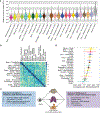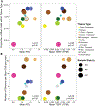Determinants of telomere length across human tissues
- PMID: 32913074
- PMCID: PMC8108546
- DOI: 10.1126/science.aaz6876
Determinants of telomere length across human tissues
Abstract
Telomere shortening is a hallmark of aging. Telomere length (TL) in blood cells has been studied extensively as a biomarker of human aging and disease; however, little is known regarding variability in TL in nonblood, disease-relevant tissue types. Here, we characterize variability in TLs from 6391 tissue samples, representing >20 tissue types and 952 individuals from the Genotype-Tissue Expression (GTEx) project. We describe differences across tissue types, positive correlation among tissue types, and associations with age and ancestry. We show that genetic variation affects TL in multiple tissue types and that TL may mediate the effect of age on gene expression. Our results provide the foundational knowledge regarding TL in healthy tissues that is needed to interpret epidemiological studies of TL and human health.
Copyright © 2020 The Authors, some rights reserved; exclusive licensee American Association for the Advancement of Science. No claim to original U.S. Government Works.
Conflict of interest statement
Figures






Comment in
-
Reaching completion for GTEx.Nat Rev Genet. 2020 Dec;21(12):717. doi: 10.1038/s41576-020-00296-7. Nat Rev Genet. 2020. PMID: 33060849 No abstract available.
References
-
- Shay JW, Role of telomeres and telomerase in aging and cancer. Cancer Discov. 6, 584–593 (2016). doi: 10.1158/2159-8290.CD-16-0062; - DOI - PMC - PubMed
Publication types
MeSH terms
Substances
Grants and funding
- R01 CA229618/CA/NCI NIH HHS/United States
- U01 MH104393/MH/NIMH NIH HHS/United States
- R01 MH109905/MH/NIMH NIH HHS/United States
- R01 MH106842/MH/NIMH NIH HHS/United States
- T32 GM007281/GM/NIGMS NIH HHS/United States
- K99 HG009916/HG/NHGRI NIH HHS/United States
- R01 HL142028/HL/NHLBI NIH HHS/United States
- R01 CA107431/CA/NCI NIH HHS/United States
- R01 MH090951/MH/NIMH NIH HHS/United States
- UL1 TR002550/TR/NCATS NIH HHS/United States
- U01 AG066529/AG/NIA NIH HHS/United States
- R01 HL134840/HL/NHLBI NIH HHS/United States
- R01 HG010480/HG/NHGRI NIH HHS/United States
- R01 DA006227/DA/NIDA NIH HHS/United States
- U41 HG002371/HG/NHGRI NIH HHS/United States
- R01 HG008150/HG/NHGRI NIH HHS/United States
- R01 MH107666/MH/NIMH NIH HHS/United States
- T32 AG051146/AG/NIA NIH HHS/United States
- UM1 HG008901/HG/NHGRI NIH HHS/United States
- U01 HG007593/HG/NHGRI NIH HHS/United States
- R01 GM124486/GM/NIGMS NIH HHS/United States
- R01 MH090936/MH/NIMH NIH HHS/United States
- U01 HG007598/HG/NHGRI NIH HHS/United States
- R25 GM109439/GM/NIGMS NIH HHS/United States
- R01 ES020506/ES/NIEHS NIH HHS/United States
- T32 DK110919/DK/NIDDK NIH HHS/United States
- R01 HG002585/HG/NHGRI NIH HHS/United States
- U01 HG007601/HG/NHGRI NIH HHS/United States
- R01 HG006855/HG/NHGRI NIH HHS/United States
- T32 HG000044/HG/NHGRI NIH HHS/United States
- P30 ES027792/ES/NIEHS NIH HHS/United States
- F32 HG009987/HG/NHGRI NIH HHS/United States
- R01 HG010067/HG/NHGRI NIH HHS/United States
- R01 MH090941/MH/NIMH NIH HHS/United States
- R01 GM122924/GM/NIGMS NIH HHS/United States
- U41 HG009494/HG/NHGRI NIH HHS/United States
- R01 MH101822/MH/NIMH NIH HHS/United States
- R35 ES028379/ES/NIEHS NIH HHS/United States
- HHSN261200800001C/RC/CCR NIH HHS/United States
- R01 MH090937/MH/NIMH NIH HHS/United States
- K22 HG000044/HG/NHGRI NIH HHS/United States
- HHSN268201000029C/HL/NHLBI NIH HHS/United States
- HHSN261200800001E/CA/NCI NIH HHS/United States
- R01 MH101814/MH/NIMH NIH HHS/United States
- R35 HG010718/HG/NHGRI NIH HHS/United States
- P30 DK020595/DK/NIDDK NIH HHS/United States
- R01 GM108711/GM/NIGMS NIH HHS/United States
- T32 AG000243/AG/NIA NIH HHS/United States
LinkOut - more resources
Full Text Sources
Medical

